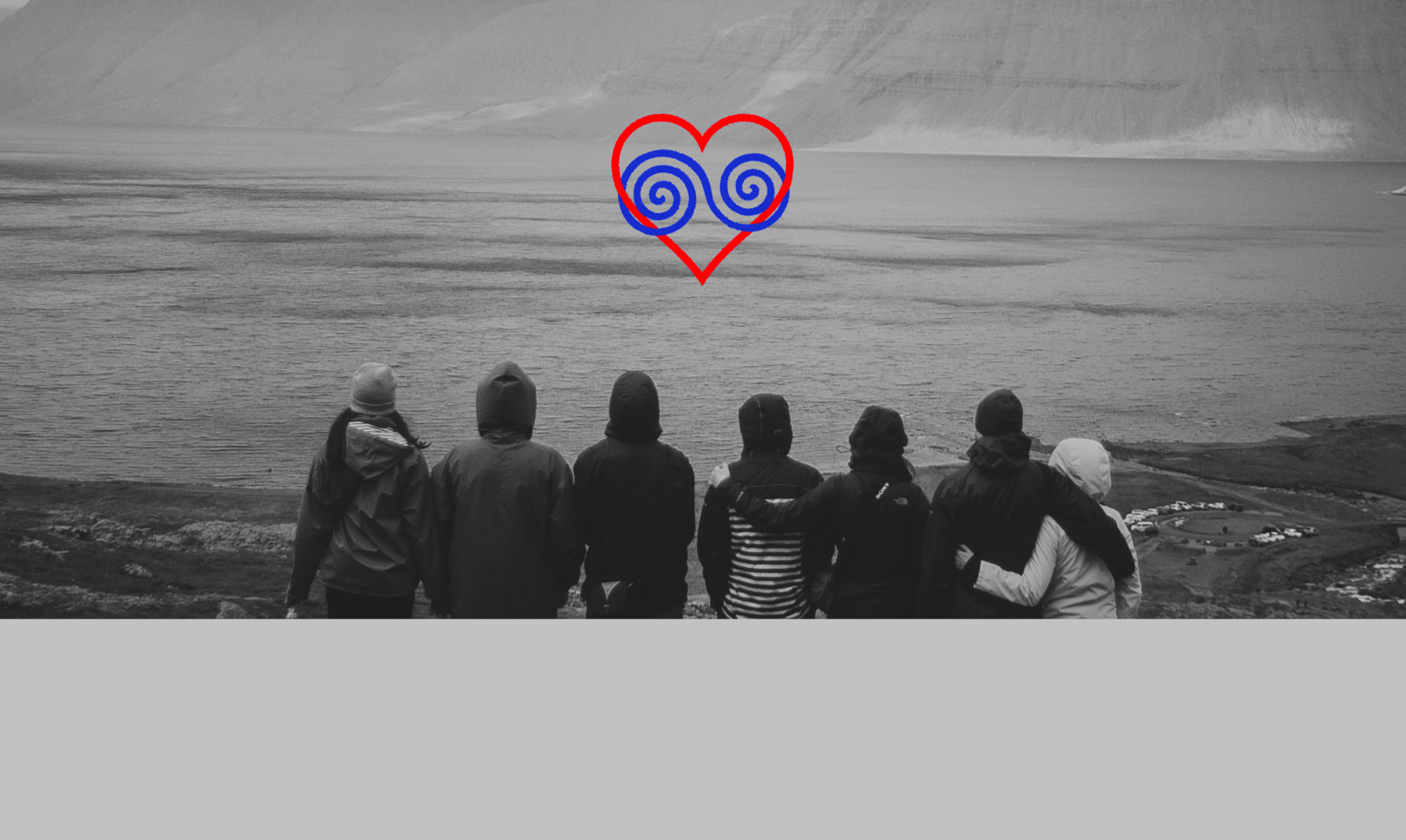Dyadic nucleus hypothesis

In the worldwide creation myths – especially concerning the creation of human beings – Polyamory somehow comes off badly.
By the way, this is not only the case with the – according to own statement¹ – “jealous” God of the Israelites, about whom all adherents of his religion can presumably be glad that he has ever created more than only one being and only one gender at all, considering that the Near Eastern Yahweh/Jehovah is almost regarded as archetype of mono-theistic and mono-normative creatorship…
No, from the plains of Asia to the coasts of Papua New Guinea, from the rainforests of South America to the icy expanses of the Arctic regions: almost everywhere in the world the history of mankind has mythologically begun first of all with only two individuals, who were quite predominantly referred to as woman and man in terms of sex and gender.
Ok, sometimes one of these two partners was a goddess who “fabricated” herself a companion in order to give birth to mankind after his assistance or there was an idle god who created a woman in order to escape the boredom of the eternity and who advanced with her to become the progenitor of humankind.
The few exceptions, where there was a situation of “more than two” right from the beginning – or where there was a positive hustle and bustle immediately from scratch – one is obliged to look for, but – thanks be to the Gods – there are also some of these:²
The gods of the ancient Maya, for example, really got into the thick of things, probably targeting a large number of people right from the start, and after disastrous attempts using initially clay (washed away by the rain) and then wood (brittle and disloyal), finally achieved such gigantic success with maize mush that the gods themselves soon felt afraid of the sheer fertile teeming of their creation.
Things are much more differentiated in the Hawaiian creation song “Kumulipo“. There, the goddess Laʻilaʻi conducts a kind of proto-polyamorous “open relationship” with two partners, from whose union three (of course divine) descendants are born, who then decide for themselves in the best rainbow manner, since they were born while their mother was with two men, to declare themselves “Poʻolua” (= “the ones whose origin is in the dark”) and to claim ancestry from both fathers.
Wonderfully polyamorous, however, I perceive above all the foundation myth of the Kiowa Apaches, who tell of their creator Kuterastan, and how he awoke and rubbed his eyes. When he peered above him into the darkness it filled with light and illuminated the darkness below. When he looked east the light became tinged with the yellow of dawn, and when he looked west the light was shaded with the amber tones of dusk. As he glanced about himself clouds in different colors appeared. Then again Kuterastan rubbed his eyes and face, and as he flung the sweat from his hands another cloud appeared with a tiny little girl Stenatliha sitting on top. Stenatliha’s name translates as the Woman Without Parents. Kuterastan and Stenatliha were puzzled where the other had come from, and where were the Earth and Sky. After thinking for some time, Kuterastan again rubbed his eyes and face, then his hands together, and from the sweat flying as he opened hands first Chuganaai, the Sun, and then Hadintin Skhin, or Pollen Boy, appeared. After the four sat a long time in silence on a single cloud, Kuterastan finally broke the silence to say, “What shall we do?” – whereupon it is told: And together they all began with creation…
In view of the overwhelming majority of exclusively dyadic (dyadic = “consisting of two units” / “concerning the interaction of two units”) creation myths, however, these remain nevertheless rather colourful marginal phenomena in a relationship-world which was obviously quite predominantly designed at the beginning above all for a get-together of (only) two beings.
So, if we leave out the purely reproductive aspect – which certainly played an essential role in early cultures (and which thus usually received a “higher” justification in mythology) – does wisdom still remain, which is not only still relevant for us today, but also has a right to appear on a bLog about multiple relationships?
Sure – rhetorical question – I certainly think that’s the case.
And in fact, this is often acknowledged also within our polyamorous lifestyle.
In an intensive exchange with the already on this platform quoted bLogger Sacriba (which lives for her part also polyamorous) she answered me once on my own statement »I believe […] that “falling in love” or “the beginning” needs phases of 1:1 time. For me this 1:1 forms the “nucleus” [of a relationship] – and in the “getting to know phase” I believe, we require some eye-to-eye togetherness in this way first of all…« the following:
»I totally agree with you on this, and would even add to it: I think that recurring one-on-one / 1:1 times are essential not only for the beginning, but also for maintaining a healthy, loving couple relationship. As the greatest possible interpersonal closeness, the romantic level is very receptive, and therefore also very vulnerable. Of course, this is even more true at the beginning. The more influences from “outside” are added, the more likely it is that the people concerned will close down and will no longer be able to interact at this level at all. This is why so many monogamous couple relationships “expire” as soon as children come along: In addition to full-time employment and being a parent, there is simply not enough time and energy left for romantic closeness, and after a few years there is none left at all.
Interestingly, a similar phenomenon happens to many people who actually try establishing a multiple relationship: For the time being, everyone is putting their time and energy into the establishment of the new shared relationship. And YES, it makes sense, because the threesome, foursome, whatever, is a new structure, which needs time and attention, especially in the “multiple relationship formation phase”. BUT: Couple relationships do not disappear as a result of this new system. On the contrary, a polycule is even defined as a “network of interrelated romantic connections”. Couple relationships continue to exist as subsystems, and with them the requirements for them to be predominantly healthy and energizing, exactly like the above-mentioned 1:1-time.«
Also in the German Facebook forum “Polyamory & Polyfidelity – The art of loving more than one“ there was just this month a short dialogue arising under an interview request with the topic “Everyday life in polyamorous relationships”:
Group member A: »I think it’s so important for outsiders to get some insight to maybe understand that it’s not that different from monogamy.«
Group member B: »Regarding this statement, one aspect comes to my mind. Basically, there are some things that are different from monogamy, but of course not everything, and one aspect strikes me directly: Poly relationships are also relationships of 2. You have an individual bond to each partner (like to your only partner in a monogamous relationship) and therefore you also need togetherness with every one of them. That’s what I find beautiful about polyamory. That love is able to flow easily, you don’t have to repress anything AND nevertheless you have distinct loves.«
Especially the statements of the two forum members, who expressed their thoughts spontaneously and straightforwardly, delight me, because I myself had already mentioned here on my bLog in Entry 29 and also repeatedly in Entry 72, that actually the whole essence of my writing could be summarized in the simple sentence “Maintain good relationships!”.
Members A and B above, in a sense, illustrate this “essence” twofold with their statements: On the one hand by expressing that polyamorous relationships are, at heart, entirely classic romantic human relationships, like every other romantic human relationship. On the other hand, that the basic structure of multiple relationships – which seem so nefarious to people not familiar with the subject precisely because of their “entangled intermingling” – consists, reduced to a common denominator, of distinct individual relationships.
I do not want to upset anyone here, if, for example, a three person relationship would feel offended now, which would have experienced the luck that all persons fell in love with each other there more or less at the same time. As a matter of fact, I would also say to such a group that it is worthwhile to reflect for a moment upon the “interrelationships” of the various members of such a “threesome” in the way that bLogger Sacriba has done above.
Because when I say “Maintain good relations!” I mean it a little like the Irish author, critic and activist George Bernard Shaw, who once wrote »Love is the ability to allow the people we care about the freedom they need to be who they want to be. Regardless of whether we can identify with it or not.«
This ability, if we want to share a romantic loving relationship with the corresponding person, in my opinion always refers to an individual. An individual from whom we (hopefully) experience the same ability in our favour the other way around.
Mr. Shaw has formulated in a concise way what has long been scientifically recognized – and what I have already quoted several times on this bLog; once again here, because it is so important:
»Intimacy is a cardinal process, defined as feeling understood, validated and cared for by partners who are aware of facts and feelings central to one’s self-conception.
Contributing to this perception is trust (the expectation that partners can be counted on to respect and fulfil important needs) and acceptance (the belief that partners accept one for who one is).
Empathy is also relevant because it signals awareness of an appreciation for a partners core-self.
Attachment also contributes to perceived partner responsiveness, notwithstanding its link to interdependence and sentiment, because of the fundamental role of perceiving that one is worthy of and can expect to receive love and care from significant others.«³
So this “process” is not automatic and, on top of that, it is – as bLogger Sacriba has quite properly observed – “very vulnerable”. Consequently, out of natural self-protection, we humans are much more likely to choose a 1:1 situation in order to first merely lower our shields when confronted with only one person, carefully discarding parts of our everyday armour on a swift-trust basis. The vast majority of us would certainly only dare such a process in a second step in front of a group. These “subsystems” – to take up a term by Sacriba – are thus to a certain extent the engine rooms of successful multiple relationship management. If these are healthy, i.e. in each case at eye level, honest, committed, trusting, and appreciative, energy can be generated that may then begin to circulate in an eventual “overall system”.
Probably this connection was latently – or even quite knowingly – clear to the narrators of the human creation myths: Apart from the famous “good relationship with ourselves”, we are indeed not capable of “multitasking” in our human connections. Thus, the very encounter with our respective direct counterpart is of special importance each time – all our attention is required, our full awareness and involvement. No matter whether in the myths the human beings originated from dust, blood, pebbles or sweat – in each case it becomes obvious rather quickly that an “I” needs above all a distinct “You” in order to understand – but also to mirror itself.
To maintain an independent, complete and entirely individual relationship with each of our favourite loved ones is therefore of considerable importance for a successful partnership network, which is also intended to succeed with more people.
Perhaps it was that awareness which the gods wanted to provide us with from the very beginning of mankind.
¹ The Bible – Exodus 20, 5: “For I, the Lord your God, am a jealous God” / Exodus 34, 14: “For Yahweh bears the name “the jealous one”; a jealous God he is.”
² All examples are taken from the collection “List of creation myths“ available on the English Wikipedia and its redirections there to the Maya gods, the Kumulipo and Kuterastan.
³ S. Cohen, L.G. Underwood and B.H. Gottlieb in “Social support measurement and intervention” – A guide for health and social scientists”, Oxford University Press, 2000.
First cited in Entry 14, but also Entry 46 (Self-knowledge), Entry 62 (Relation Ability), and Entry 71 (on Polyamory).
Thanks to Morrisio Indra Hutama on Unsplash for the picture!

